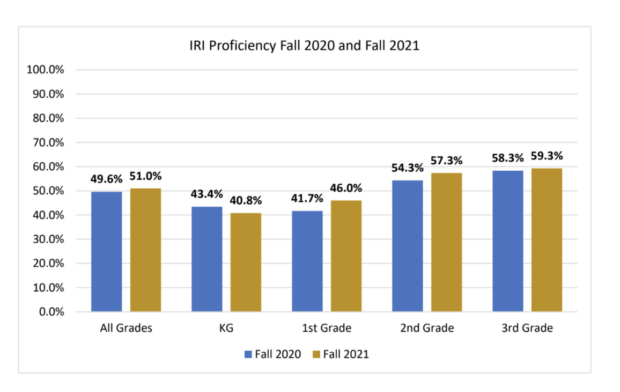About half of Idaho’s K-3rd graders were reading at grade level or better on a reading test administered this fall, a slight upward trend from the drop in reading proficiency Idaho recorded at the onset of the pandemic.
The Idaho Reading Indicator standardized test is given to students in kindergarten and grades 1-3 in the fall and again in the spring. Spring results indicate how far students have progressed over the course of the year. Fall scores are typically lower, and indicate what percent of students start the school year ready to read.
Last year, 49.6% of K-3 students started the year reading at grade level.
This year, that eeked up to 51%.
But the results are not identical across grade levels.
IRI data shows improvements in reading proficiency for students who are returning to school this fall: kids in grades 1-3 are more ready to read in 2021 than the class before them was.
Kindergarten is an exception. Only 40.8% of Idaho kindergarteners started the school year reading at the expected level — the lowest kindergarten “proficiency” score since at least 2015.
It’s a strange reversal in trend. Last year, students in grades 1-3 saw a decline in reading proficiency after their spring semester of 2020 was interrupted due to the pandemic, but kindergarteners actually saw a slight increase in proficiency. Some 43.5% of kindergarteners started the 2020 school year ready to read.
In a news release, Superintendent Sherri Ybarra pointed to the kindergarten scores to show the need for full-day kindergarten, something that she and the State Board of Education plan to advocate for during the January legislative session.
“Incoming kindergarteners were the only students for whom reading-readiness was lower than for the previous year’s cohort,” Ybarra wrote. “It is essential to give children a strong educational foundation when they enter school.”

While the fall results show improvement over last year’s, they’re not up to pre-pandemic levels. In the fall of 2019, 55% of Idaho students were considered proficient in reading. That’s still four percentage points higher than this year’s results.
“Scores for first- through third-graders still fall short of pre-pandemic levels, and that is not a surprise considering the learning loss caused by pandemic disruptions,” Superintendent Sherri Ybarra said in a news release. “But these latest results indicate we are making headway.”
The results also indicate students saw a drop in reading-readiness over the summertime transition from one grade to the next, a common phenomenon.
- 61.3% of kindergarteners scored proficient in the spring of 2021. Of that cohort of students, now entering first grade, only 46% percent scored proficient this fall.
- 59.5% of first graders scored proficient in the spring of 2021; 57.3% scored proficient entering second grade this fall.
- 69.2% of second graders scored proficient in the spring of 2021; 59.3% scored proficient entering third grade this fall.
*Note that the IRI test itself changed in 2018, making it difficult to compare results before and after that year.*
For the most recent and publicly available data on a variety of student proficiency measures, click here.
